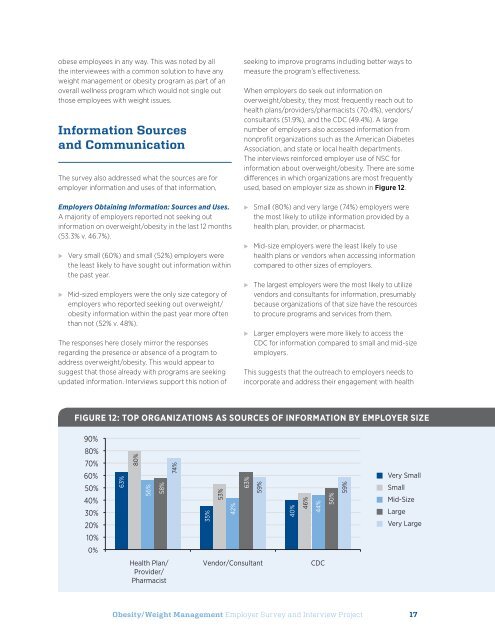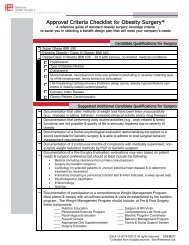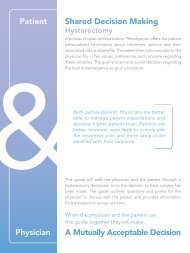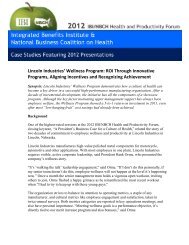Obesity/Weight Management Employer Survey and Interview Project
Obesity/Weight Management Employer Survey and Interview Project
Obesity/Weight Management Employer Survey and Interview Project
- No tags were found...
Create successful ePaper yourself
Turn your PDF publications into a flip-book with our unique Google optimized e-Paper software.
obese employees in any way. This was noted by allthe interviewees with a common solution to have anyweight management or obesity program as part of anoverall wellness program which would not single outthose employees with weight issues.Information Sources<strong>and</strong> CommunicationThe survey also addressed what the sources are foremployer information <strong>and</strong> uses of that information,<strong>Employer</strong>s Obtaining Information: Sources <strong>and</strong> Uses.A majority of employers reported not seeking outinformation on overweight/obesity in the last 12 months(53.3% v. 46.7%).E Very small (60%) <strong>and</strong> small (52%) employers werethe least likely to have sought out information withinthe past year.E Mid-sized employers were the only size category ofemployers who reported seeking out overweight/obesity information within the past year more oftenthan not (52% v. 48%).The responses here closely mirror the responsesregarding the presence or absence of a program toaddress overweight/obesity. This would appear tosuggest that those already with programs are seekingupdated information. <strong>Interview</strong>s support this notion ofseeking to improve programs including better ways tomeasure the program’s effectiveness.When employers do seek out information onoverweight/obesity, they most frequently reach out tohealth plans/providers/pharmacists (70.4%), vendors/consultants (51.9%), <strong>and</strong> the CDC (49.4%). A largenumber of employers also accessed information fromnonprofit organizations such as the American DiabetesAssociation, <strong>and</strong> state or local health departments.The interviews reinforced employer use of NSC forinformation about overweight/obesity. There are somedifferences in which organizations are most frequentlyused, based on employer size as shown in Figure 12.E Small (80%) <strong>and</strong> very large (74%) employers werethe most likely to utilize information provided by ahealth plan, provider, or pharmacist.E Mid-size employers were the least likely to usehealth plans or vendors when accessing informationcompared to other sizes of employers.E The largest employers were the most likely to utilizevendors <strong>and</strong> consultants for information, presumablybecause organizations of that size have the resourcesto procure programs <strong>and</strong> services from them.E Larger employers were more likely to access theCDC for information compared to small <strong>and</strong> mid-sizeemployers.This suggests that the outreach to employers needs toincorporate <strong>and</strong> address their engagement with healthFigure 12: Top Organizations as Sources of Information by <strong>Employer</strong> Size90%80%70%60%50%40%30%20%63%80%56%58%74%35%53%42%63%59%40%46%44%50%59%Very SmallSmallMid-SizeLargeVery Large10%0%Health Plan/Provider/PharmacistVendor/ConsultantCDC<strong>Obesity</strong>/<strong>Weight</strong> <strong>Management</strong> <strong>Employer</strong> <strong>Survey</strong> <strong>and</strong> <strong>Interview</strong> <strong>Project</strong> 17









